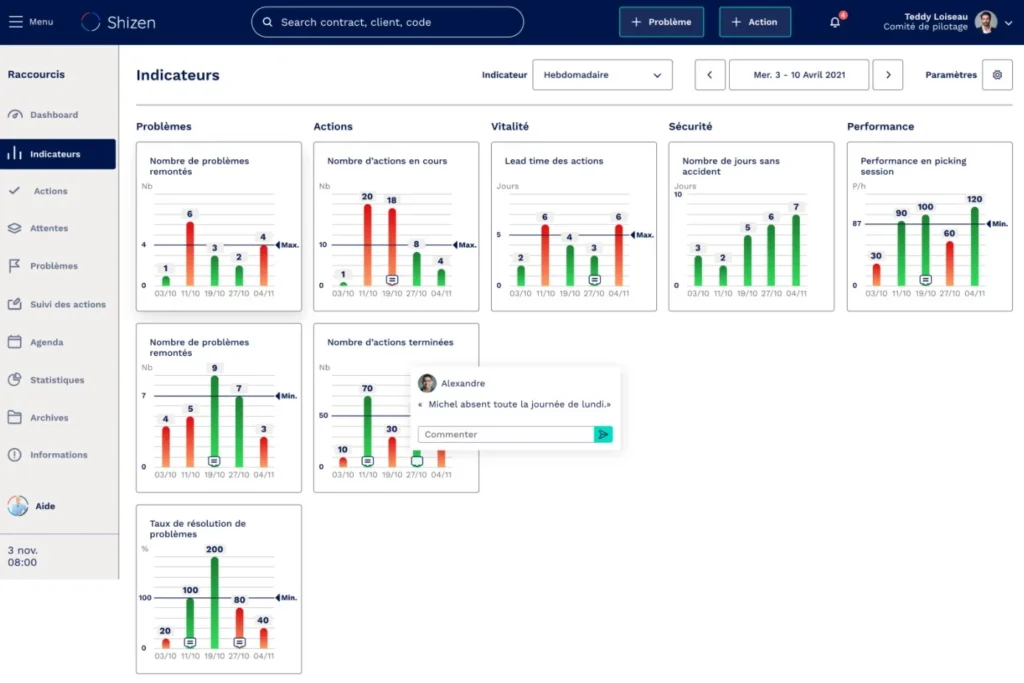Generally in the industrial environment, the performance indicators represent different performance criteria, we speak of SQCDE/M/P indicators.
Security
Quality
Costs
Time limit
Environment
Motivation / Personal
In each of these categories, the organization will be able to monitor relevant indicators specific to its business and sector.
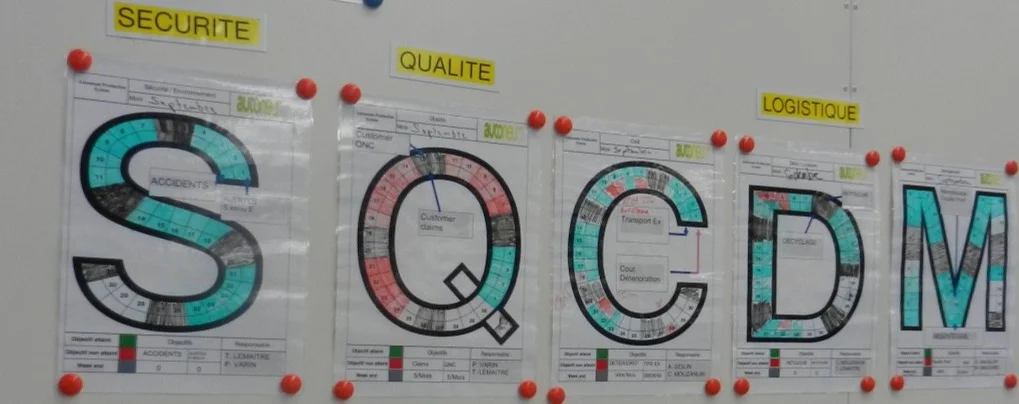
Here is an example of an SQCDM wall display on paper, some companies still use these methods, but most today have gone digital. A digital system allows the historization of data, the instantaneous sharing of information with the right people (escalation) and also a better traceability of actions and data etc…
These performance measurement criteria are sometimes specific to a production team or workshop. Their definition must be done as a team in order to allow employees to work together on a reflection around the optimization of their performance.
Operational indicators can be established in order to concretize, at the level of each pole, precise objectives and the resources necessary to achieve them. Each group will have to determine which dimension to measure, what is the frequency of measurement and especially what is the target value.
The 6 criteria that define a good performance indicator:
An indicator must be:
1) Performance oriented, measures progress according to the objective
The indicator measures the deviation from the objective to be monitored. However, in reality, it sometimes happens that we find dashboards made up of indicators that are not linked to the performance objectives of the moment.
Explanation: This can happen when the objectives change and new indicators are monitored, sometimes we decide to keep the old ones on the dashboards because the data “is interesting”. But an overloaded dashboard does not make it easy to read.
2) Clear
Its calculation is simple and we know precisely what it corresponds to.
Explanation: Any user of the indicator should know precisely how it is constructed and why it is so constructed. To make decisions based on an indicator, it is necessary to have complete confidence in the information provided. And trust is earned through knowledge.
3) Refreshed “Real Time”
Always refreshed in time, that is, at the time of its use, the data is up to date.
Explanation: However, this does not mean that it is essential to accelerate all cycles. Quarterly report information is released…every three months.
4) Available effortlessly
From a Lean point of view, information must be available in the field effortlessly, in a short time and without complex and expensive tools.
Explanation: Building data collection infrastructure is always much more expensive than it looks. Some data collection systems are complex to set up and require a lot of resources. It is therefore important to find the most relevant indicator and at the same time the most accessible. The easier the information is to find, the more viable the indicator will be in the long term.
5) Reliable
Again, the point seems obvious. However, always in the “real life” of the company, it happens that the decision maker doubts the reliability of the data used to build the indicator. Of course, he won’t use it. Or conversely, it happens that we make a decision on the basis of erroneous or partial data.
Explanation: This is also the issue of trust. An indicator can be reliable in the sense of those who built it, and doubtful for those who will have to use it. In fact, he won’t use it until the doubts are cleared up.
6) Decisive, involves “action”
We are not satisfied with a simple “observation” which does not induce any idea of action. An indicator should be a decision-making aid. If the indicator is not in line with its objective, problem solving must be in progress and the deviation must be documented.
Explanation: An indicator in the red should allow you to take an immediate decision: go and see the problem directly on the machine, start problem solving, etc.
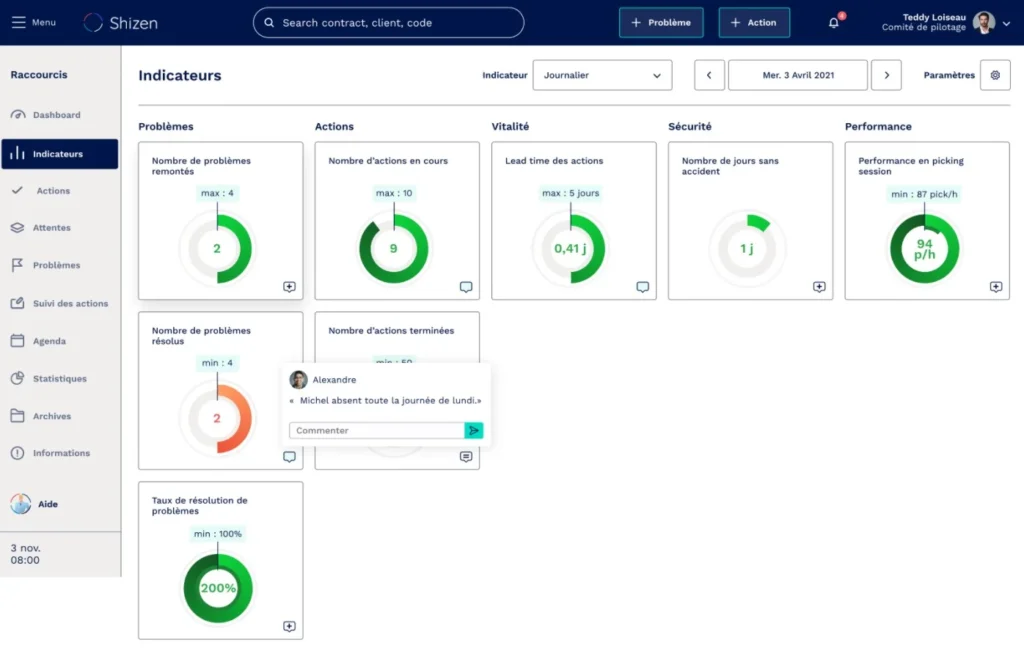
Here is an overview of the Shizen solution which allows you to follow all its indicators on a virtual dashboard. The indicators can be relative to a team, shared with other teams, then reported to management with a data consolidation system.
How to monitor and analyze these performance indicators?
First of all, it is necessary to define the organization of performance rituals with their frequency, then we define the indicators necessary for the smooth running of these rituals. The frequency and temporality of the indicators must be consistent with the frequency of the ritual. Daily result indicator for a daily ritual, etc.
Monitoring actual performance makes it possible to ensure that the objectives are on the way to being met, and to quickly identify any deviation between the results and the expected figures, to allow corrective actions to be put in place if necessary.
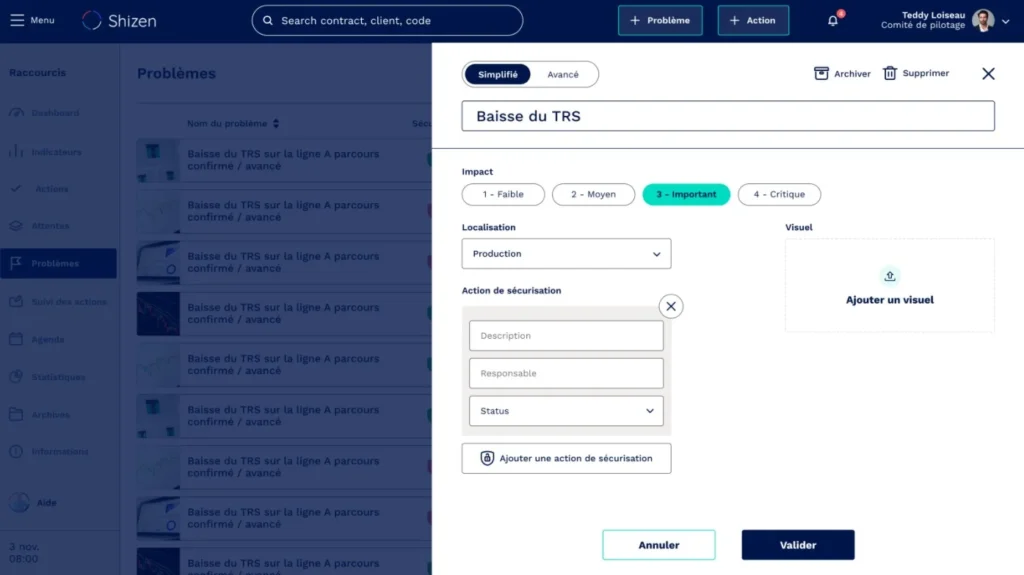
Here is an overview of an instant problem escalation with the Shizen digital solution, including a security action. Scoring the impact of the problem allows the team leader to be able to decide the urgency of the resolution of this problem.
Performance management does not stop at indicators:
If an indicator is trending down, a problem may be escalating. Reporting problems is the basis of continuous improvement, solving them and deploying the corresponding solutions is the best way to sustain your performance approach and ensure the health of your organization over the long term.
When you do your problem solving, be careful to be in a multidisciplinary team: that is to say, to have people from the different trades concerned by the problem in question, the idea is to have an overall view of the situation and to be able to brainstorm with different perspectives. And this in order to share the global vision of the process or the instance that causes the problem with all the stakeholders.
However, be careful not to turn your resolutions into lectures. Limit the number of participants, in order to avoid the overload of ideas and to favor the implementation of actions.
Once you have:
1) clearly defined your problem using the QQOQCCP,
2) found the root cause using a 5 Why and/or an Ishikawa,
you just have to determine the corrective actions that can eradicate the problem forever! The best way to do this is to tie every action you decide to do to a verified root cause. So you are sure not to waste time doing tasks that ultimately have an indirect impact on solving your problem.
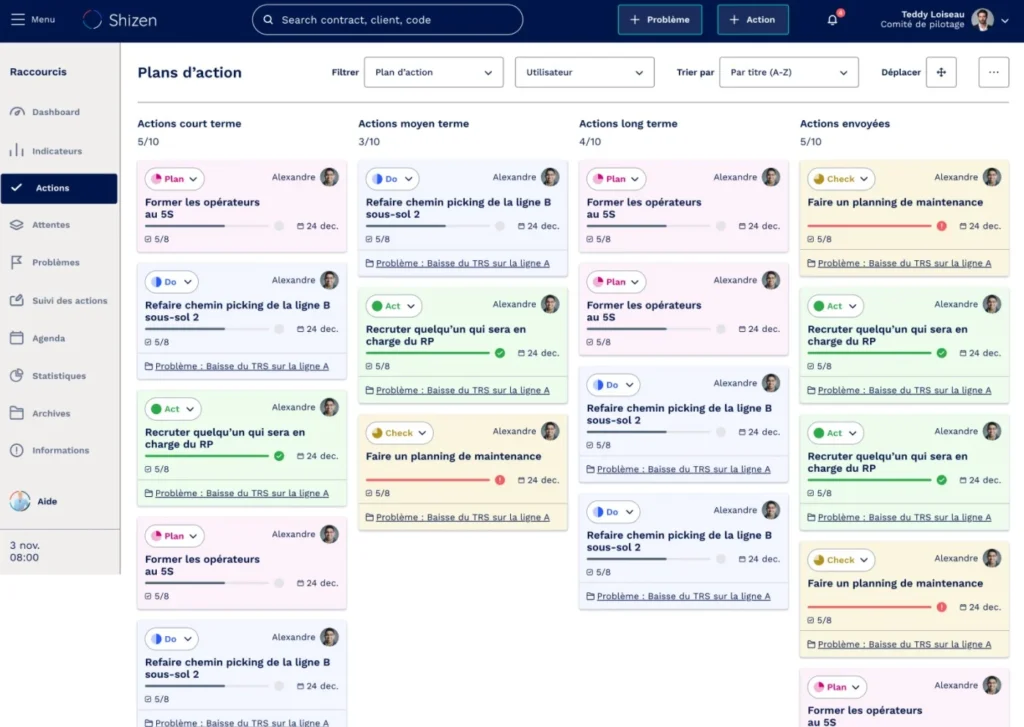
Here is a dashboard of a team’s actions in the Shizen digital solution. The follow-up of each action is done through the PDCA. As you can see, some actions are related to a problem. In this example the actions are organized by “vertical action plans” an easy way to navigate when you have a lot of actions.
Conclusion :
When it comes to business performance, everything is linked:
Step 1: The data is brought up from the field to feed the indicators.
Step 2: These indicators are clear enough for the decision maker to alert a problem.
Step 3: The decision maker assembles a team to solve it.
Step 4: The team implements and monitors the actions that will correct the trend displayed by the indicator.
The digital solution makes it possible to offer a complete panel of tools to manage each of these stages. For example, at Shizen, these tools are interconnected which makes it a real management system. Data entered by team members, or via the API connected to your machines, is saved on a secure server. Where paper methods have their limits: loss of information, transcription by hand on excel files for data consolidation… digital offers rapid sharing and problem logging, in order to find which solutions worked on a similar problem. Thus, each user can instantly find all the old problem resolutions carried out by the team.
If you are curious to see what a digital solution can bring to your organization on a daily basis in terms of tools, methodology or overall system. I invite you to participate in one of our Shizen Live to discover our entire solution.
